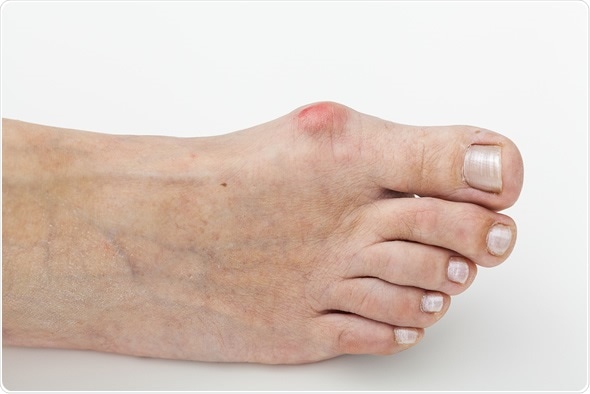A bunion, also known as hallux vulgus, is a deformity of the bone at the bottom of the big toe. It causes the big toe to turn in towards the smaller toes and sometimes overlap with the second toe. Occasionally, a bunion can also cause a deformity in the second toe. A lump can form on the top of the joint which may become inflamed, red, blistered, or infected. Some bunions cause pain while others do not. The size of a bunion can also vary.

Image Copyright: Photographee.eu, Image ID: 150622418
Who Suffers from Bunions?
Both men and women can have bunions but they are more common in women. About 15% of all women in the UK have bunions. Children can also suffer from bunions.
Why do Bunions Form?
In most cases, bunions are not caused by shoes alone. There are many reasons why this deformity arises in a person.
Bunions do tend to run in families suggesting that there may be a genetic link in some cases. If a member of your family such as a parent already has them, this can increase the risk of you developing them. People who have very flexible joints can be more prone to bunions and this can be an inherited bone condition. Also, low muscle tone can encourage bunions.
Arthritis can lead to bunions. Rheumatoid arthritis is an autoimmune disease that causes inflammation and pain in joints. Due to the way that it affects joints, it can lead to bunions in the toes. Psoriatic arthritis is seen in around one in five people who suffer from the flaky skin condition called psoriasis. It can affect the joints of the body. The big toe foot joint can develop a bunion. Gout, another form of arthritis more common in men than women, is another potential cause of arthritis. This can result in pain in the toe joint, swelling and red shiny skin over the bunion area.
Cerebral palsy, a disease that affects people from birth can result in stiffness in the patient’s movement. Marfan syndrome impacts the connective tissues of the body. The condition which develops in 1 in every 5000 people can cause bunions in affected people.
Badly fitted shoes can encourage bunions. Shoes that do not offer enough support can be the culprits such as high heels and shoes where the toes are crammed at the front. Strapless shoes can also be a problem.
How to Avoid Bunions?
Wearing lower-heeled shoes, up to 4 cm, can help a patient to avoid bunions on the feet. Wide fittings with enough space for comfort are also sensible ways to minimize risk of a bunion. Backless shoes should be avoided. Ideally shoes should have straps or laces to keep the foot in place. Backless shoes can lead to the toes clawing inside the shoes at the front for extra support. Ideally a patient with the condition should wear shoes with different heel heights. Exercises that involve calf muscles can also help keep the feet in good condition.
References
Further Reading
Last Updated: Dec 30, 2022